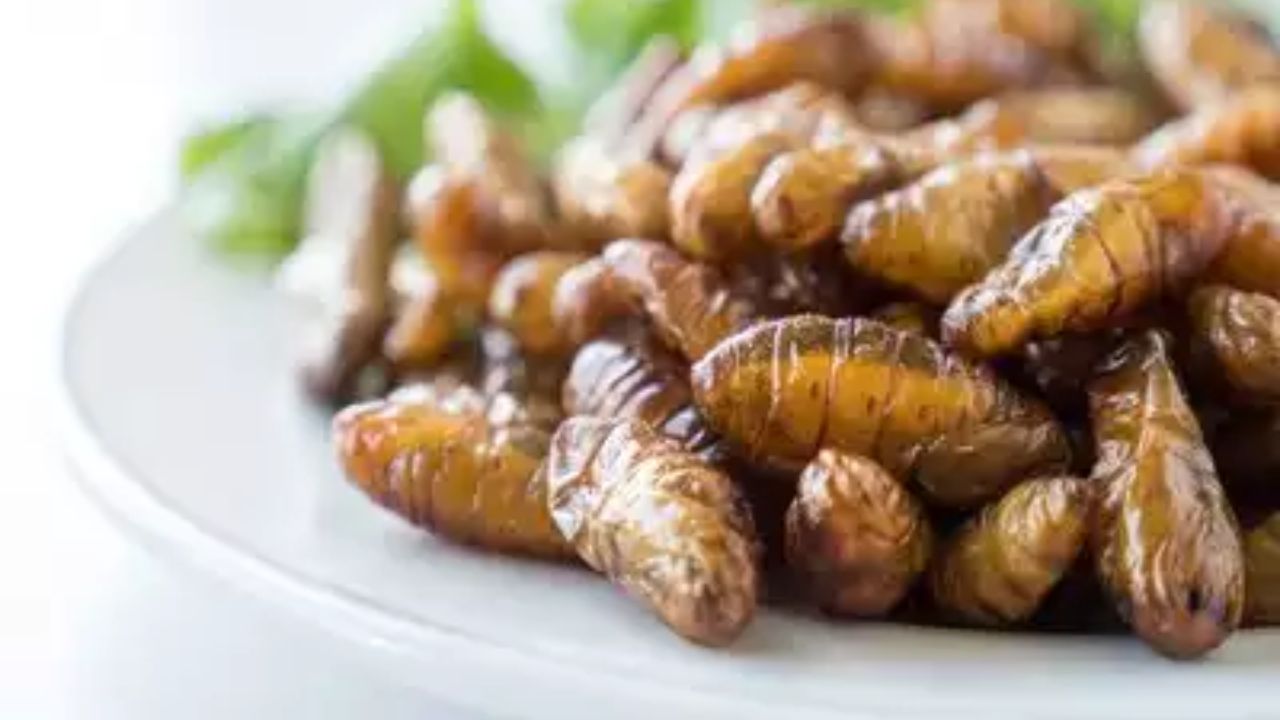Hey there, curious food adventurers! Today, we’re diving into a world of wonder and taste buds with a list of some truly wacky foods eaten in India. From spicy surprises to sweet shocks, Indian cuisine has a whole bunch of surprises up its sleeve. So, buckle up your taste buds and get ready for a journey through the Top 10 Most Bizarre Foods Eaten In India!

10.Bhang Pakore
Bhang Pakore might sound like a magical dish from a fairy tale, but it’s actually a real treat enjoyed by many in India. These crispy, fried fritters are made using a unique ingredient called “bhang,” which comes from the leaves and flowers of the cannabis plant. Yes, you heard it right – cannabis!
Now, before you get too excited, it’s important to know that consuming bhang pakore isn’t all fun and games. While it may give you a temporary feeling of relaxation or euphoria, it can also have some not-so-pleasant side effects. Eating too much bhang can lead to dizziness, confusion, nausea, and even hallucinations. So, while it might seem like a wild ride, it’s best to approach bhang pakore with caution and moderation.
9.Sa-um Bur
Sa-um Bur is a unique dish that hails from the northeastern state of Manipur in India. It’s made from a special ingredient called “sa-um,” which is essentially fermented pork fat. This fatty concoction is then wrapped in banana leaves and left to ferment for weeks, resulting in a pungent and intense flavor.
Despite its popularity among certain communities in Manipur, Sa-um Bur isn’t everyone’s cup of tea. Its strong odor and rich taste can be quite overwhelming for those not accustomed to it. Additionally, excessive consumption of fermented foods like Sa-um Bur can sometimes lead to digestive discomfort or upset stomachs. So, while it may be a delicacy for some, it’s not without its potential drawbacks.
8.Onion Ka Halwa
Onion Ka Halwa might sound like a sweet treat, but it’s actually a savory dessert that might surprise your taste buds! Originating from the northern parts of India, this unique dish is made by caramelizing onions in ghee (clarified butter) and then simmering them with milk, sugar, and aromatic spices until they transform into a rich, creamy halwa.
While it might seem unusual to use onions in a dessert, Onion Ka Halwa is cherished for its complex flavors and hearty texture. However, it’s important to note that indulging in too much of this rich delicacy might not be the best idea for everyone. Onions are known to cause digestive discomfort and bloating in some people, especially when consumed in large quantities. So, while you may enjoy the unique taste of Onion Ka Halwa, it’s best to savor it in moderation to avoid any tummy troubles!
7.Daulat ki Chaat
Daulat ki Chaat is a whimsical dessert that hails from the streets of Old Delhi, India. This unique sweet treat is made by churning milk until it forms a light, airy froth, which is then delicately flavored with saffron, sugar, and sometimes even silver leaf for a touch of luxury.
While Daulat ki Chaat may look like a dreamy cloud of sweetness, it’s not without its quirks. This ethereal dessert is extremely delicate and requires careful handling to maintain its fluffy texture. Additionally, because it’s made from dairy products, Daulat ki Chaat may not be suitable for those who are lactose intolerant or have dairy allergies. So, while it’s a delightful indulgence for many, it’s important to enjoy it mindfully and considerately of any dietary restrictions.
6.Eri Polu
Eri Polu is a traditional dish from the northeastern state of Assam, India, known for its distinctive ingredients and flavors. This unique delicacy features eri silkworm pupae, which are rich in protein and considered a delicacy in certain parts of the region.
While Eri Polu might be a beloved dish for some, it’s not for the faint of heart. The idea of consuming silkworm pupae might be a bit unsettling for those unfamiliar with it. Additionally, some people might find the texture of the pupae to be a bit challenging to swallow.
Despite its unconventional ingredients, Eri Polu holds cultural significance in Assam and is enjoyed by many as a special treat. However, it’s important to approach this dish with an open mind and a hearty appetite for adventure!
5.Frog Legs
Frog legs might hop onto your plate as a surprising delicacy in certain parts of India, particularly in regions with a strong culinary tradition influenced by French cuisine. These amphibian appendages are often prepared by marinating them in a flavorful blend of spices and then frying or grilling them to perfection.
While frog legs might seem like an exotic treat, they’re not without controversy. Some people have concerns about the ethical implications of consuming frog meat, as it raises questions about sustainability and animal welfare. Additionally, there’s always the risk of contamination or foodborne illnesses if the frog legs aren’t prepared properly.
Despite these considerations, frog legs remain a popular dish in certain culinary circles, appreciated for their tender texture and unique flavor. However, it’s essential to approach this dish with an awareness of its environmental impact and to ensure that it’s sourced responsibly. So, if you’re feeling adventurous, frog legs might just leap onto your list of must-try foods!
4.Khorisa
Khorisa is a traditional dish from the northeastern state of Assam, India, known for its bold flavors and cultural significance. This unique delicacy is made from fermented bamboo shoots, which are a staple ingredient in Assamese cuisine.
While Khorisa might be a beloved dish for many in Assam, it’s not without its challenges. The pungent aroma and tangy taste of fermented bamboo shoots might be an acquired taste for those unfamiliar with it. Additionally, some people might experience digestive discomfort if they’re not accustomed to consuming fermented foods.
Despite these potential drawbacks, Khorisa holds a special place in Assamese cuisine and is cherished for its distinctive flavors and textures. It’s often enjoyed as a side dish or incorporated into various traditional recipes, adding depth and complexity to the culinary experience.
3.Black Rice
Black rice, also known as “Forbidden Rice,” is a unique variety of rice that boasts a striking dark color and a nutty flavor profile. Originating from the northeastern state of Manipur in India, black rice has a long history and is prized for its nutritional benefits.
While black rice might not seem bizarre in terms of appearance, it stands out from its more common white or brown counterparts due to its distinctive hue and earthy taste. However, some people might be surprised to learn that black rice isn’t as widely consumed as other varieties and is often considered a specialty or gourmet ingredient.
Despite its relative rarity, black rice has gained popularity in recent years due to its impressive health benefits. Rich in antioxidants, fiber, and essential nutrients, black rice is celebrated for its potential to promote heart health, improve digestion, and support overall well-being.
So, while black rice might not be the most bizarre food on our list, its unique characteristics and nutritional profile make it a fascinating addition to any culinary adventure. Whether enjoyed on its own or incorporated into creative dishes, black rice offers a delightful twist to traditional rice dishes and a chance to explore the diverse flavors of Indian cuisine.
2.Nahkham
Nahkham is a traditional dish from the northeastern state of Nagaland, India, known for its adventurous ingredients and bold flavors. This unique delicacy features fermented soybeans, which are a staple ingredient in Naga cuisine.
While Nahkham might be a beloved dish for many in Nagaland, it’s not for the faint of heart. The strong aroma and intense taste of fermented soybeans might be an acquired taste for those unfamiliar with it. Additionally, some people might find the texture of Nahkham to be a bit challenging to swallow.
Despite its unconventional ingredients, Nahkham holds cultural significance in Nagaland and is enjoyed by many as a special treat. However, it’s important to approach this dish with an open mind and a hearty appetite for adventure!
1.Red Ant Chutney
Red Ant Chutney is a unique and adventurous dish originating from the northeastern state of Manipur, India. This unconventional chutney is made from a surprising ingredient – red ants and their eggs!
While the idea of consuming ants might seem strange at first, Red Ant Chutney is actually a delicacy in certain communities in Manipur. The ants and their eggs are collected from anthills and then carefully prepared with a blend of spices, including chili, garlic, and ginger, to create a tangy and spicy chutney.
Despite its unusual ingredients, Red Ant Chutney is cherished for its bold flavors and nutritional benefits. Ants are rich in protein and other essential nutrients, making this chutney not only a culinary adventure but also a source of sustenance in traditional Manipuri cuisine.
However, it’s essential to approach Red Ant Chutney with caution, especially for those with allergies or sensitivities to insect products. Additionally, proper preparation and hygiene practices are crucial to ensure the safety and cleanliness of the dish.
So, if you’re feeling adventurous and curious about exploring the diverse flavors of Indian cuisine, why not give Red Ant Chutney a try? It’s sure to be a memorable experience that will tantalize your taste buds and broaden your culinary horizons!
